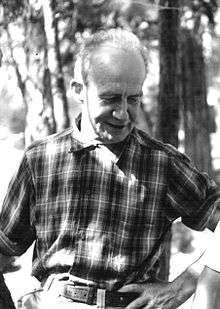John Salathé
| John Salathé | |
|---|---|
 John Salathé at Camp 4 in Yosemite Valley in 1964. | |
| Born |
June 14, 1899 Niederschöntal, Füllinsdorf municipality, Switzerland |
| Died | August 31, 1992 |
| Occupation | Blacksmith, rock climber |
John Salathé (June 14, 1899 – 1993)[1] was an American pioneering rock climber, blacksmith, and the inventor of the modern piton.
Early life
Salathé was born in Switzerland and emigrated to the United States. He had been a blacksmith before an illness and a mid-life spiritual conversion led him to devote his life to ascetic meditation, vegetarianism and rock climbing.
Lost Arrow pitons
When he began climbing in 1945, he found that traditional pitons used for climbing in the Alps were too soft to be driven into narrow cracks without buckling. In his San Mateo business, Peninsula Wrought Iron Works,[1] Salathé used high-carbon chrome-vanadium steel, similar to that used to make Ford axles, to forge extremely strong pitons which could be hammered into the hard Yosemite granite without buckling, as well as removed without getting mangled, thus rendering them reusable. These thin pitons became known as Lost Arrows, and are still manufactured under that name by Black Diamond Equipment, Ltd.
Ascents
In 1946, Salathé and Anton (Ax) Nelson climbed the southwest face of Half Dome. The two climbers spent the night on a small ledge, making it Yosemite's first climbing route to require a bivouac.[2]
In September, 1947, Salathé and Nelson managed the first "ground-up" ascent of the Lost Arrow Spire in Yosemite, by the Lost Arrow Chimney route. The Lost Arrow piton was named after the spire. The ascent took five days and included four bivouacs. The first ascent of the spire summit was achieved in 1946 by Anton Nelson and friends, who threw a rope over the summit beforehand to aid in their climb.[2][3]
In July, 1950, Allen Steck and Salathé made the first ascent of the 1,500 foot (500 m) north face of Sentinel Rock. This five-day ascent was considered the last of the great Yosemite problems of the day.[2] Their route, the Steck-Salathé Route is now a classic rock climb.
Later life
In 1953, Salathé suffered a mental breakdown, abandoned his family, and returned to Switzerland. He became a devoted member of a religious group called the Spiritual Lodge Zurich. He climbed the Matterhorn in August, 1958, his last significant mountaineering achievement. In 1963, he returned to the United States and spent 20 years wandering through the mountains and deserts of California, maintaining his vegetarian diet based largely on wild grasses and herbs that he sought out, and preaching his religious beliefs.
Death and legacy
Salathé died on August 31, 1992.[4]
The Salathé Wall on El Capitan was named to honor Salathé (although he did not climb it) around 1960 by Yvon Chouinard.[5]
References
- 1 2 Allen Steck, Robin Hansen (1994). "In Memoriam: John Salathé" (PDF). American Alpine Journal. 36 (68): 321–322.
- 1 2 3 Jones, Chris (1976). Climbing in North America. Berkeley, California, USA: American Alpine Club / University of California Press. pp. 185–194. ISBN 0-520-02976-3.
- ↑ Challacombe, J. R. (June 1954). "The Fabulous Sierra Nevada". The National Geographic Magazine. Vol. CV no. Six. Washington, DC: National Geographic Society. pp. 826–830.
- ↑ Roper, Steve (1994). Camp 4: Recollections of a Yosemite Rockclimber. Seattle, WA: The Mountaineers. pp. 48–49. ISBN 0-89886-587-5.
- ↑ Roper, Steve; Steck, Allen (1979). Fifty Classic Climbs of North America. San Francisco: Sierra Club Books. p. 269. ISBN 0-87156-292-8.